IN THIS ISSUE
- Right whale winter pros, cons
- Yellow-bellied sapsuckers
- Rare plant has landowner's help
- When a red-tailed hawk is white
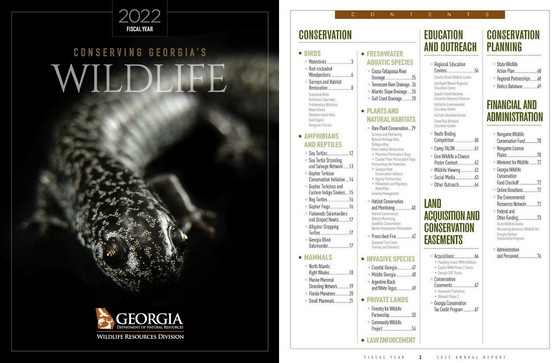 Before 2022 slips too far into the rear-view mirror, take time to review the conservation successes and challenges that filled that fiscal year for the Georgia DNR Wildlife Conservation Section and its partners.
From record-high nest counts for bald eagles and loggerhead sea turtles to the first time federally listed frosted flatwoods salamanders were bred in captivity, it’s all in this annual report, which can be viewed in flip-page format or downloaded.
The Wildlife Conservation Section works to save and restore native Georgia wildlife that aren’t fished for or hunted, plus rare plants and natural habitats. But the agency also depends primarily on fundraisers, grants and contributions.
Want to help conserve these animals, plants and places? Here's how.
-
Buy an eagle or monarch butterfly license plate or renew these or an older design, like the hummingbird tag. Most of the $25 cost goes to wildlife.
- Donate to the Georgia Wildlife Conservation Fund at gooutdoorsgeorgia.com. Click “Licenses and Permits” to create an account.
- Contribute through the Wildlife Conservation Fund state income-tax checkoff. Details at georgiawildlife.com/donations.
- Volunteer with DNR and join conservation organizations such as our friends group, The Environmental Resources Network. More at gooutdoorsgeorgia.com and tern.homestead.com.
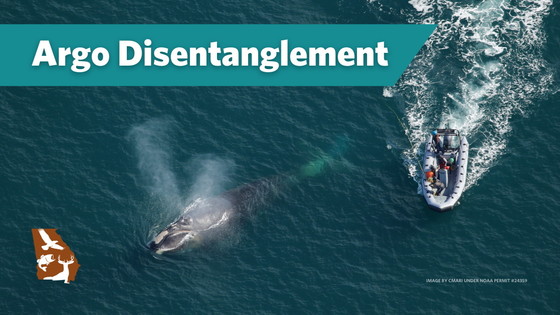 It has been an up-and-down winter for North Atlantic right whales, Georgia’s state marine mammal and one of the world’s most imperiled large whale species.
The good: Two right whales were disentangled from commercial fishing gear in two weeks in the Southeast. The most recent rescue, led by Georgia DNR and documented in this video and blog post, freed an adult male named Argo from lobster pots and rope he had dragged more than 800 miles from Canadian waters. Also read about disentangling right whale 3812 (Nimbus).
The bad: Entanglement in fishing gear is the leading threat facing North Atlantic right whales. By one estimate, over 80 percent of the some 340 right whales left have been entangled. Trying to disentangle them is dangerous and done only by experts. It’s also a last-ditch effort to save the whale. For example, Argo was in poor shape, the weight and drag of the pots carving the rope into his tail. He may not survive and hasn’t been seen since.
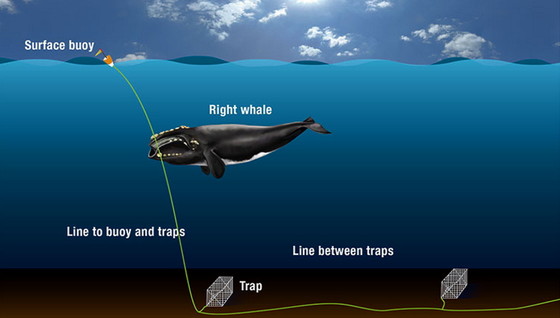 NOAA graphic illustrates how commercial fishing traps pose entanglement risks for right whales
The ugly: The winter calving season off the Southeast, the species’ only known calving grounds, began strong but has slowed. The calf count is at 12, including one found dead in North Carolina. Last winter’s total was 15. Also, an adult male stranded dead in Virginia – findings indicate it was hit by a vessel – and a young female was spotted off North Carolina with a lethal entanglement.
The outlook: Testing and calls for whale-safe commercial fishing gear continue. Opposition to such change and the costs entailed is stiff. Other factors in play include politics, vessel strikes (the second leading threat to right whales), warming waters affecting the whales’ main food source – copepods – and a shrinking number of breeding females.
Quotable: Centuries of commercial whaling almost drove North Atlantic right whales to extinction in the late 19th century. Now they are on the brink again, if from different human causes. Said DNR senior wildlife biologist Clay George, "We’ve been given a second chance to save them. It's just a matter of will.”
 Yellow-bellied sapsuckers (credits, from left, Jenny Burdette Photography, Terry W. Johnson, Katy Manley)
By TERRY W. JOHNSON
Even if you’ve never seen a yellow-bellied sapsucker, chances are you are familiar with the name.
Growing up, the guys I hung out with would call you a yellow-bellied sapsucker if you refused to do something they thought made you look like a coward. I didn’t learn until years later there was a bird named yellow-bellied sapsucker.
Since these unusual woodpeckers don’t act cowardly, I have no idea how they came to be synonymous with that trait. Their name actually comes from the fact they eat lots of sugary sap, which they obtain by drilling small holes in more than 1,000 trees and woody plants.
But they don’t suck the sap into their mouth: They sop it up. …
Learn more about these colorfully named Georgia visitors in Terry’s column.
Terry W. Johnson is a retired DNR manager and executive director of TERN, friends group of the Wildlife Conservation Section. Check out past columns and his blog. Permission is required to reprint a column.
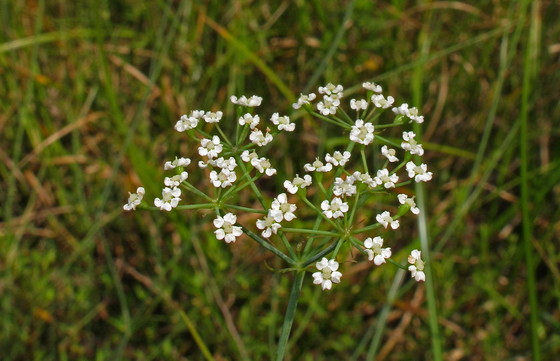 Canby's dropwort (Alan Cressler)
By ETHAN HATCHETT
Endangered Canby’s dropwort is one of more than 650 plant species rated of special concern for conservation in Georgia.
It’s also one that underscores the primary problem facing rare plants – habitat loss and fragmentation – and the fact that with 93 percent of Georgia’s landscape in private ownership, private landowners are critical to conserving plants.
Alan Woodward knows that connection. His family’s farm in Dooly County has one of the healthiest populations of Canby’s dropwort in Georgia. The plants were found there more than 40 years ago.
Yet Woodward sees safeguarding them as a family tradition. "It’s something I can’t imagine not doing, really,” he said.
Read about this family's commitment to conserving Canby’s dropwort.
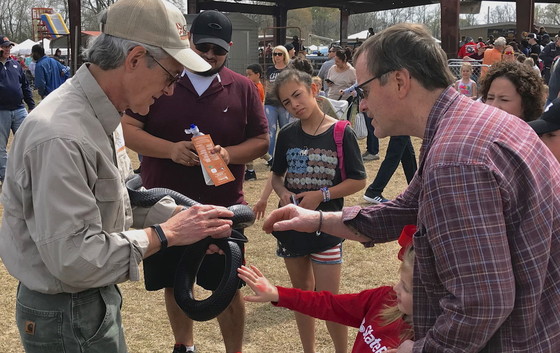 DNR's Dr. Jon Ambrose shows an eastern indigo snake to Claxton festivalgoers (Linda May/DNR)
Georgia’s two rattlesnake festivals and a former roundup that’s gone to the birds will offer fun and wildlife next month. First up is the Whigham Rattlesnake Roundup on March 4, followed by the Claxton Rattlesnake and Wildlife Festival March 11-12. Benefiting rattlers, both are no-kill events. Claxton made the change in 2012 and Whigham in 2022. Both also showcase snakes and other wildlife in educational programs, along with attractions varying from food and crafts to entertainment. Fitzgerald’s Wild Chicken Festival, a former rattler roundup that switched in 2000 to celebrating the local flock of Burmese wild chickens, will welcome a crowd March 17-18. Among the draws is a crowing contest, of course.
It's time to burn. While DNR crews led or helped with prescribed fires across the state, Gov. Brian Kemp promoted controlled burns to restore and improve wildlife habitat by proclaiming Feb. 6-10 Prescribed Fire Awareness Week in Georgia. Coming up: Savannah River Fire Festival including a demo burn and Burner Bob, March 4 at the UGA Mary Kahrs Warnell Forest Education Center in Guyton.
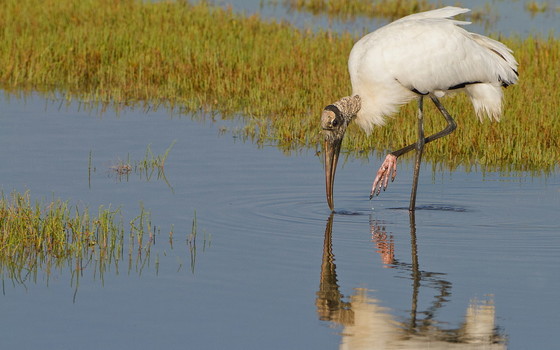 Wood stork feeding at Jekyll Island (Ty Ivey/GNPA)
As the Endangered Species Act turns 50, the U.S. Fish and Wildlife Service is proposing to remove wood storks from the endangered species list. Listed in 1984 when there were fewer than 5,000 breeding pairs, North America’s only native stork has rebounded to 10,000-plus pairs and spread its range – Georgia now has a fifth of the nesting population – thanks to habitat protections. Delisting Q&A. Stork's status in Georgia.
Georgia’s Youth Birding Competition returns to its roots this spring but is keeping the wider birding timeframe adopted during the pandemic. Teams will check-in for the traditional event-ending banquet and awards ceremony at Charlie Elliott Wildlife Center April 22. But they can look for birds statewide during any 24-hour stretch starting as soon as 5 p.m. April 14. Register here. Don’t forget the companion Art Contest, with submissions due by March 13.
 Striped newt (Mark Mandica/Amphibian Foundation)
The recent find of a striped newt in a second pond at Alapaha River Wildlife Management Area increased by about 25 percent the number of ponds where these rare newts are known from outside of Florida. A candidate for Endangered Species Act listing, striped newts are a pond-breeding amphibian that has suffered sharp declines, largely because of too little fire on the landscape and habitat loss.
Gopher frogs also fit the profile as pond breeders in trouble and a high-priority species in Georgia’s State Wildlife Action Plan. In January, DNR and partners collected gopher frog egg masses from seasonal wetlands in the Coastal Plain and handed them off to Warm Springs National Fish Hatchery, UGA, Amphibian Foundation and Gaskins Forest Education Center to hatch and rear them to “froglets” for release at restoration sites. Also see: DNR gopher frog blog.
With former President Jimmy Carter on hospice care, remembrances of his conservation efforts include the then-governor's 1973 veto of plans for a dam on the Flint River at Sprewell Bluff. Carter later wrote: "I have had many people come up to me and confess that they cursed me profoundly when I vetoed the dam. But now they are thankful for my having done it. They are glad the river was saved."
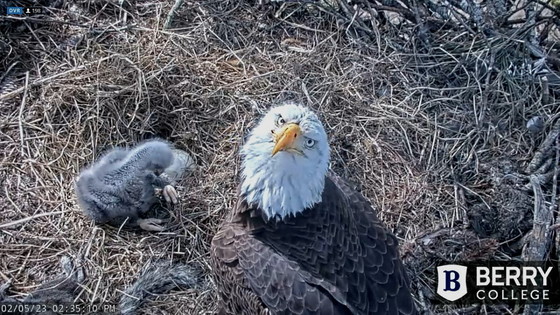 Quick hits:
- The nesting bald eagles livestreamed by Berry College are staying busy with B16, their lone but fast-growing eaglet.
- DNR and the U.S. Fish and Wildlife Service are offering a reward for information leading to an arrest in the shooting of a bald eagle in Irwin County (the eagle had to be euthanized because of its injuries). Call DNR's game warden hotline (800-241-4113) or Fish and Wildlife at (404) 679-4000.
- As the Georgia General Assembly moves into the second half of its 2023 session, the Georgia Conservancy continues tracking conservation-related legislation with weekly e-mail updates.
- The Georgia Environmental Protection Division opened a 60-day public comment period last month on Twin Pines Minerals’ draft plan to mine titanium near Okefenokee National Wildlife Refuge.
- Georgia Audubon has received a Richard King Mellon Foundation grant to raise awareness of bird-friendly native plants, reduce the spread of invasive plants and increase monitoring of invasives.
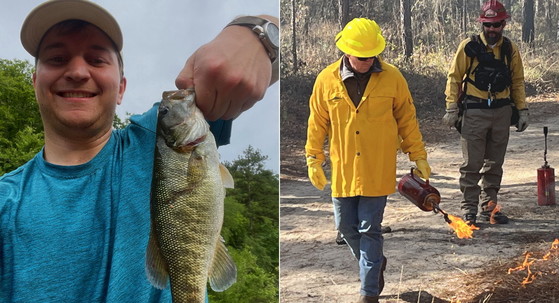 Bass Slam grand prize winner Andrew Wood (left) and Gov. Kemp lighting a fire line (special to DNR; Jason Lee/DNR)
Names in the news: Not only was Gov. Brian Kemp headlining Prescribed Fire Awareness Week this month, in late January he and First Lady Marty Kemp were stringing a fire line as part of a demo burn at Weekend for Wildlife, an annual fundraiser benefiting DNR’s Wildlife Conservation Section. Anglers Andrew Wood (pictured) and Daniel Woodcock were the respective grand-prize winners among anglers who landed a DNR Bass Slam or an Angler Award last year. DNR wildlife interpretive specialist Amber Barrow and wildlife biologist Kevin Rose got a shout-out in this column about a Conservation Leaders for Tomorrow program held at Charlie Elliott Wildlife Center. Wildlife Conservation Section staff Shan Cammack and Linda May will give talks on longleaf pine ecosystems at the Columbus Botanical Garden’s Naturalist Symposium March 18. Conservationist, author and professor Doug Tallamy is the keynote speaker. DNR Cpl. Tyler Lewis, who works Cobb County and Lake Allatoona, has been named the Law Enforcement Division’s 2022 Georgia Boating Safety Officer of the Year.
WHAT YOU MISSED ...
In the previous Georgia Wild:
- Eagle emergencies
- Awww-some whale video
- Rufous hummers' sorry state
- Watersnake vs. American eel
(video, audio) "Endangered right whale (Argo) entangled in fishing gear freed by biologists," Fox Weather. Also: CNN, WTLV/WJXX-TV (Jacksonville, Fla.), Georgia Public Broadcasting, Treasure Coast (Fla.) Newspapers, WRAL-TV (Raleigh, N.C.).
"How to disentangle a 40-foot right whale (Nimbus)," Garden & Gun. Also: Atlanta Journal-Constitution.
(audio) "Lobster fishers sue to block closure meant to aid whales," New Hampshire Public Radio
"Tricolored bat at risk of endangerment in state," Georgia Public Broadcasting
"Feds: Reptile dealers smuggled thousands of creatures from U.S.," The State (Columbia, S.C.)
"Scientists working to bolster threatened gopher frog numbers," SaportaReport
"DNR Youth Birding Competition returns to its roots," Yahoo!News (from Marietta Daily Journal)
"Georgia biologist on do’s, don’ts for feeding wild birds," WSAV-TV (Savannah)
"Ossoff urges state to block mine near Okefenokee," Georgia Public Broadcasting
"The volunteers behind the Savannah nest cam," Savannah Morning News
"Remembering a Georgia original: Okefenokee Joe," Garden & Gun
"Draft trispot darter recovery plan announced," U.S. Fish and Wildlife Service
"Final recovery plan for white fringeless orchid available," U.S. Fish and Wildlife Service
"Report: More than a third of U.S. wildlife at risk of extinction," LiveScience
(audio) "'Tis the season for baby right whales," Sapelo NERRds podcast
Deer with dangling tongue explained, DNR Facebook
"Wild Quail Hunting Safety," Tall Timbers
 Leucistic red-tailed hawk in Catoosa County compared to common red-tailed (Dylan McCollum; Ty Ivey/GNPA)
The photo on the left by Dylan McCollum in Catoosa County recently raised eyebrows and questions: Namely, what bird is that? DNR wildlife biologist Todd Schneider said it’s a leucistic red-tailed hawk. And, yes, it is rare. According to Schneider, 2000-2007 data from the Cornell Lab of Ornithology’s Project FeederWatch listed about 1 in 30,000 birds with abnormal plumage coloration. Some 80 percent of those were leucistic. Another 3 percent were albino. The rest had other color abnormalities such as melanism, an excess of dark pigment. Schneider explained that albino birds have no melanin – the substance that produces their eye, skin and feather coloration – while leucistic birds have some melanin but the transfer to the feathers is incomplete, leading to all white or patchy white feathers. Which is why leucistic and albino birds often look alike. By the way, a few days ago he heard about a leucistic hawk near Winder. All the more reason to watch birds!
CREDIT
Masthead: yearling frosted flatwoods salamander (Mark Mandica/Amphibian Foundation)
Top
|